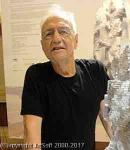Frank Gehry
Frank Gehry
Place: Toronto
Born: 1929
Biography:
Frank Owen Gehry, CC, FAIA is a Canadian-born American architect, residing in Los Angeles.
A number of his buildings, including his private residence, have become world-renowned attractions. His works are cited as being among the most important works of contemporary architecture in the 2010 World Architecture Survey, which led Vanity Fair to label him as "the most important architect of our age".
Gehry's best-known works include the titanium-clad Guggenheim Museum in Bilbao, Spain; Walt Disney Concert Hall in downtown Los Angeles; Louis Vuitton Foundation in Paris, France; MIT Ray and Maria Stata Center in Cambridge, Massachusetts; The Vontz Center for Molecular Studies on the University of Cincinnati campus; Museum of Pop Culture in Seattle; New World Center in Miami Beach; Weisman Art Museum at the University of Minnesota in Minneapolis; Dancing House in Prague; the Vitra Design Museum and the MARTa Herford museum in Germany; the Art Gallery of Ontario in Toronto; the Cinémathèque Française in Paris; and 8 Spruce Street in New York City.
It was his private residence in Santa Monica, California that jump-started his career. Gehry is also the designer of the future National Dwight D. Eisenhower Memorial.
Gehry was born Frank Owen Goldberg on February 28, 1929, in Toronto, Ontario, to parents Sadie Thelma (née Kaplanski/Caplan) and Irving Goldberg. His father was born in Brooklyn, New York, to Russian Jewish parents, and his mother was a Polish Jewish immigrant born in Łódź. A creative child, he was encouraged by his grandmother, Leah Caplan, with whom he would build little cities out of scraps of wood. With these scraps from her husband's hardware store, she entertained him for hours, building imaginary houses and futuristic cities on the living room floor.
His use of corrugated steel, chain-link fencing, unpainted plywood and other utilitarian or "everyday" materials was partly inspired by spending Saturday mornings at his grandfather's hardware store. He would spend time drawing with his father, while his mother introduced him to the world of art. "So the creative genes were there", Gehry says. "But my father thought I was a dreamer, I wasn't gonna amount to anything. It was my mother who thought I was just reticent to do things. She would push me."
He was given the Hebrew name "Ephraim" by his grandfather, but only used it at his bar mitzvah.
In 1947, his family immigrated to the United States settling in California. Gehry got a job driving a delivery truck, and studied at Los Angeles City College, eventually to graduate from the University of Southern California's School of Architecture. During that time, he became a member of Alpha Epsilon Pi.
According to Gehry, "I was a truck driver in L.A., going to City College, and I tried radio announcing, which I wasn't very good at. I tried chemical engineering, which I wasn't very good at and didn't like, and then I remembered. You know, somehow I just started wracking my brain about, 'What do I like?' Where was I? What made me excited? And I remembered art, that I loved going to museums and I loved looking at paintings, loved listening to music. Those things came from my mother, who took me to concerts and museums. I remembered Grandma and the blocks, and just on a hunch, I tried some architecture classes." Gehry graduated with a Bachelor of Architecture degree from USC in 1954.
After graduating from college, he spent time away from the field of architecture in numerous other jobs, including service in the United States Army. In the fall of 1956, he moved his family to Cambridge, where he studied city planning at the Harvard Graduate School of Design. He left before completing the program, disheartened and underwhelmed. Gehry's left-wing ideas about socially responsible architecture were under-realized,[clarification needed] and the final straw occurred when he sat in on a discussion of one professor's "secret project in progress"—a palace that he was designing for right-wing Cuban dictator Fulgencio Batista (1901–1973).
Gehry returned to Los Angeles to work for Victor Gruen Associates, to whom he had been apprenticed while at the USC School of Architecture. In 1957 he was given the chance to design and construct his first private residence at the age of 28, with friend and old classmate Greg Walsh. Built in Idyllwild, California for his wife Anita's family neighbor Melvin David, "The David Cabin", shows features that were to become synonymous with later work. The over 2,000 sq ft (190 m2) mountain retreat has unique design features with strong Asian influences, stemming from his earliest inspirations at the time like Shosoin Treasure House in Nara, Japan, among others. Beams protrude from the exterior sides, vertical grain douglas fir detail, and exposed, unfinished ceiling beams are prominent features.
More...
Wikipedia link: Click Here





